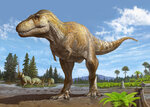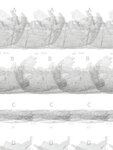Wind: 26.5 mph, W
Welcome to our new web site!
To give our readers a chance to experience all that our new website has to offer, we have made all content freely avaiable, through October 1, 2018.
During this time, print and digital subscribers will not need to log in to view our stories or e-editions.




In front of a gaggle of school children and various officials, paleontologists gathered Thursday, Jan. 11 to unveil a dinosaur jawbone discovered almost 40 years ago.
“They found a big toothy thing,” Dr. Anthony Fiorillo, executive director of The New Mexico Museum of Natural History & Science (NMMNHS) said during the event, held in Santa Fe and shared remotely.
When the fossils (several pieces of a skull) were found on the east side of Elephant Butte Reservoir in 1983 by members of the Rio Grande Sailing Club out of Las Cruces, it was thought to be part of a Tyrannosaurus rex.
In 2013, when then-student Sebastian Dalman began a restudy of a found horned dinosaur, it forced a broader rethink of the dinosaurs from western New Mexico.
“I started working on this project with co-author Steve Jasinski and soon we started to suspect we were on to something new,” Dalman said.
Dahlman said as he was looking at the bones back in 2013, he noticed some significant differences between the find and T. rex. He confirmed it was a new species and invited the others to join in the work.
A team of scientists from New Mexico; Pennsylvania; Washington DC; Utah; Ontario, Canada; and Bath, United Kingdom was assembled to study the animal, going through the skeleton bone by bone. In each case, they found subtle differences between the specimen and the dozens of T. rex skeletons that had been found before. Because T. rex is so well-known, it became possible to show the New Mexico tyrannosaur was something new.
Now that team has published their study (in the journal Scientific Reports) recognizing a new subspecies, Tyrannosaurus mcraeensis. The predator is older and more primitive than its better-known cousin, but just as large, up to 40 feet long and 12 feet high.
Fiorillo said the research is indebted to the first wave of people who excavated the bones.
“This is a discovery decades in the making,” he said. “At that time, the fossil record of tyrannosaurus was not so robust as it is today.”
He said science is a process and continuously forces people to go back and test and challenge what is known.
“To me, this discovery underscores the value, the reason this museum holds such large collections,” he said. “We have the largest paleontological collections in the entire southwestern United States. What you see on the display is just the tip of the iceberg.
“We are here to foster the spirit of curiosity that encourages scientific inquiry from a very early age.”
Joining the press conference on Zoom from the United Kingdom, Dr. Nick Longrich, a co-author from the Milner Centre for Evolution at the University of Bath talked about the differences between the new species and the known T. rex.
“The differences are subtle, but that’s typically the case in closely related species. Evolution slowly causes mutations to build up over millions of years, causing species to look subtly different over time,” he said.
Longrich said the discovery suggests instead of the species coming gradually from Mongolia across the Bering Strait, it actually evolved in the southwest, right down here in New Mexico and Mexico.
Dr. Spencer Lucas, Paleontology Curator at NMMNHS, said at first it was assumed the fossils came from the same geological time interval as T. rex, who lived in a 66–68-million-year interval where all T. rex fossils come from.
“But it turns out in the years since, we found volcanic ash beds in the rocks that had this fossil and we were able to get numerical ages,” Lucas said. “We can be sure this fossil is 72-73 million years old.”
To put the discovered dinosaur in perspective, Fiorillo asked the students how many have seen “Jurassic Park,” and plenty of hands went up.
“Tyrannosaurus rex is a big bone-chewing, Jeep-crunching dinosaur,” he said. “The more slender jaw here means Tyrannosaurus mcraeensis might have been a bone-chewing, Fiat-crunching dinosaur.”
Someone in the audience asked where the name had come from. Fiorillo said the name comes from the rock unit where these bones came from, called the McRae Group.
Captain Alexander McRae was a union soldier and artillery officer who died in the 1862 Civil War battle of Valverde Crossing, Lucas said.
These fossils were collected on lands administered by the U.S. Bureau of Reclamation. The partial skull of the Tyrannosaurus mcraeensis is on view at the New Mexico Museum of Natural History & Science. To learn more, visit nmnaturalhistory.org.